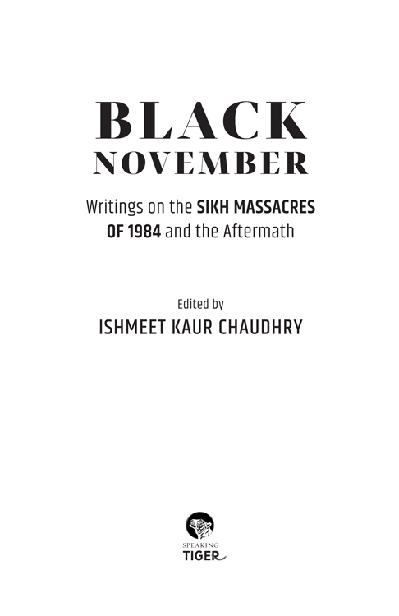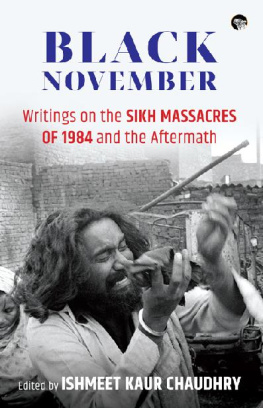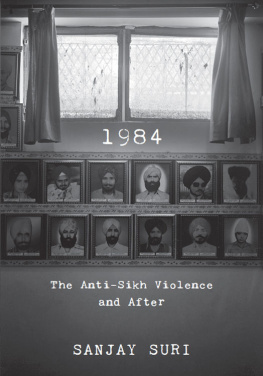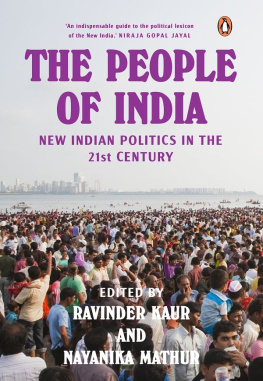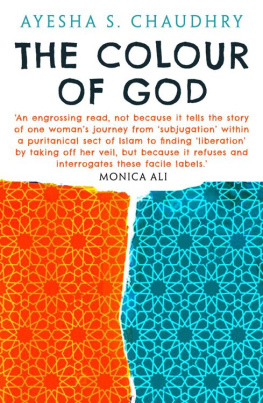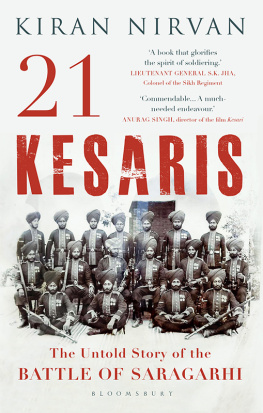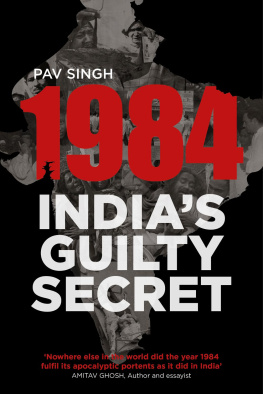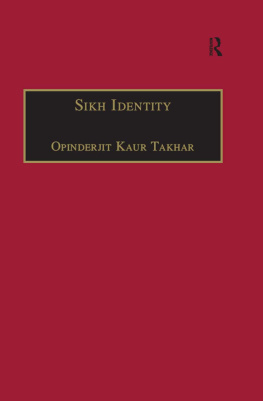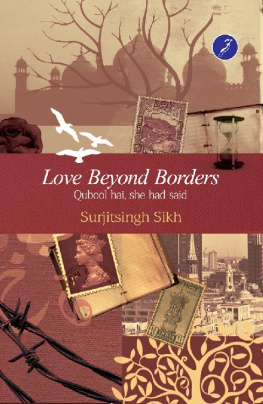Ishmeet Kaur Chaudhry teaches at the Centre for English Studies at the Central University of Gujarat, Gandhinagar. She is the editor Patrick White: Critical Issues (2014), co-editor of Violence, Subversion and Recovery: Women Writers from the Sub-continent and Around (2019, with Rachel Bari) and the author of Texting the Scripture: Sri Guru Granth Sahib and the Visionary Poetics of Patrick White (2016).
Dedicated to all the innocent victims across the world who have survived their times, despite all oppression and exploitation, and still have the courage to fight endlessly against injustice.
For my daughter, Harsheel Kaur,
who will grow up to read these stories of survival and strength
Contents
SECTION I
T
Our House Was Full: Shakuntala and Harbans Singh
interviewed by Ishmeet Kaur Chaudhry
Chaurasi Cannot Be Forgotten: Attar Kaur and Relatives
interviewed by Ishmeet Kaur Chaudhry
Cheeja Kaur and Relatives
interviewed by Ishmeet Kaur Chaudhry
We Always Gave the Vote to Congress: Phanda Singh
interviewed by Uma Chakravarti
BadshahMaintain Our Honour: Balwant Singh Granthi
interviewed by Kulbir and Anil
31 October 1984
Jarnail Singh
Now the Tears Have Dried Up
Dhiren Bhagat
Manmohan Singh and Gursharan Kaur
interviewed by Daman Singh
Had Sardarji Lived
Harsh Mander
SECTION II
S
SECTION III
P
Section IV
Poems
Introduction
Following the assassination of Indira Gandhi, the Prime Minister of India, by her own bodyguards on the morning of 31 October 1984, innumerable innocent Sikhs were humiliated, beaten, lynched and burnt alive over three days. New Delhi in particular, the political centre and capital of the nation, became the site of uncontrolled civil unrest and violent mayhem against many ordinary citizens whose only fault was that they belonged to the same Sikh community as the assassins.
Nearly thirty years later, in April 2014, as we walked into the Tilak Vihar Widows Colony, which had been established in 1985 to house the widows and families of the Sikhs killed in the 1984 pogrom, we felt innumerable eyes upon us. The sight of our tripod was scoffed at, with onlookers saying, They have come againno one does anything, they just hold their cameras and walk in. We had been taken by a contact, a person who worked in my cousins office, whose family had been victims of the pogrom. We entered a house and I was immediately overwhelmed by the stink of the moisture from the walls. The walls had been covered by tiles so that the seepage wouldnt be visible, but it nevertheless made itself felt. The drawing room had three sofas, and four women were already assembled there, waiting for us. A curtain hung at the entrance of the adjoining room and I could hear the voices of some young people inside. It seemed to me that a young man had just returned from his office. He chose to remain aloof. A kitchen adjoined the room on the other side, with an open shelf on which utensils were neatly arranged. The women seated themselves on the sofas and I was given a chair to sit behind my camera and the tripod. They were keen to talk to us, unlike the onlookers outside. They began narrating their woeful tales and as we heard story after story, we began wondering how these women had endured all that they told us. I only wished it was an exaggeration, but the truth couldnt be denied. Every word that they spoke was truth that they had lived through.
As they spoke, it seemed that their lives had been spent in a quest for justice, in pursuit of which they had grown old. This quest was their only motivation for enduring the manifold challenges of their lives. For them, going on strikes (dharnas) had become a common routine. Many of them recounted that their children would naturally accompany them to the dharnas and, in turn, realize the wrongs done to them and the need to seek justice. The dharnas bore little outcome, as, even after thirty years, the women had only received petty jobs and compensation worth rupees six or seven lakhs.
The women narrated their struggle, often remembering their past and returning to the present like the sway of a pendulum. They recalled how their lives changed drastically overnight. Ever since, they have been haunted by the senseless murders of their husbands and other family members. Most of the men had left their homes in the morning following the routine of jobs or school, but that evening they never returned. The women said that each time they heard an account of how someone else had been killed, they felt that the same thing might have happened to their loved ones. The gruesome nature of the pogrom has left its ghost behind to haunt the survivors. Many of the women recounted how they still wake up and panic about the safety of their families, even now.
The women we spoke to had several stories to share about the night when the mobs returned to rape them. The electricity supply had been cut and the men lit candles, found women and young girls, and raped them. One woman recalled that they tried to cover their girls with dupattas but, as one man was followed by another in a continuous chain the whole night, the coverings wouldnt stay in place for even a few minutes. Afterwards, many women thought of committing suicide, however, ultimately they had no choice but to continue living and look after their children. They recalled how they saw each other the next day, and shared their grief and suffering, realizing that they were all the same. This, in a way, allowed them to carry on. One of the survivors, Kulwant Kaur, remarked that they could continue living only because they saw each other as all victims of the same fate.
While recalling these events, the survivors began expressing guilt, either for having survived, unlike so many others they knew, or for not being able to save others. They spoke about how they continue to live with this guilt, and continually justify their survival to themselves, by holding themselves accountable for their children or old parents or even siblings. Alongside this, they tend to examine the reasons why they were attacked, looking for ways to say that the violence was or was not their fault.
Whether they followed the Sikh religion or not, their cultural affiliation to Sikhism was clearly the overwhelming cause of the killings, and so, unsurprisingly, the survivors spent a long time in defining their relationship with the religion. They begin defining a separate Sikh identity for themselves, in the manner in which they were othered. Many of them recalled their childhoods and how they grew up with Sikh sentiments of brotherhood. One common narrative described how it used to be difficult to differentiate between Sikh and Hindu families, as there was a long-standing tradition of mixed families: Hindus and Sikhs used to be members of the same family. For example, one survivor in Ahmedabad, who wishes to remain unnamed, recalled that his grandfather had eleven children. Out of eight sons, four were brought up as Sikh and four as Hindus. Two of the daughters were married to Hindu men and one to a Sikh man. The speaker recalled how, during the pogrom, the Sikh brothers had been targeted while the Hindu brothers remained safe. His grandmother began doubting her decision to bring up the sons with different religious identities after the pogrom, though at the same time, she was proud of how her Hindu sons had helped several Sikh men, not only their own brothers. He remarked that he could never understand the concept of a separatist Sikh identity in the context of his mixed family. He said that he felt as confused as his grandmother when suddenly Hindus began considering Sikhs to be of another religion, and vice-versa. His conclusion was that we have all been victims of politics and politicians, who had fooled the general public.
